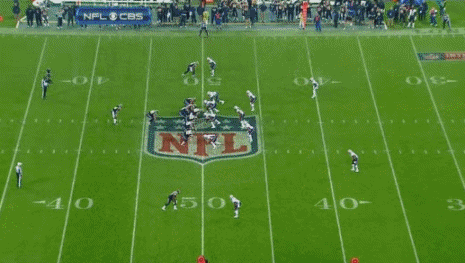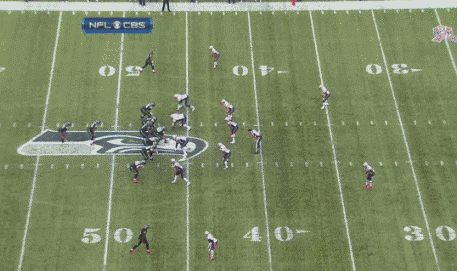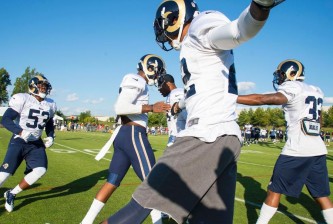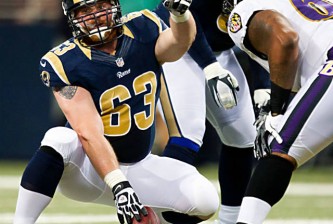| Situation: | 1st and 10 from the 50, 12:35 left in the 1st Quarter, tied at 0 |
| Personnel: | 21 |
| Play: | I Right Fake Press LT Boot Right 78 |
| Defense: | 4-3, Cover-2 Zone |
The NFL is a copycat league. In both the long term and the short term, teams are always looking at other teams and trying to find out how they are winning. Without a doubt, the most copied team in this league over the last decade has been the New England Patriots. However, today we’ll look at how the Rams took a page out of the Seahawks playbook to burn the Patriots.
Two weeks ago, while trailing by 6 with 1:27 left to play in the game, Seahawks rookie quarterback, Russell Wilson dialed up a 47-yard bomb to Sidney Rice for a game-winning touchdown.
Flash forward to 2 minutes and 25 seconds into the Rams / Patriots match up. The Rams have the ball nearly at the same spot on the field as the Seahawks had the ball, and run virtually the same play to get an early lead on the Patriots.
Pre-Snap
The Rams come out in 21 personnel, lined up in an I-Right formation. Bradford is under center with running back Steven Jackson (39) 7 yards deep and fullback Brit Miller (49) 3 yards in front of him. Tight End Mike McNeill (89) is on the line to the right of the formation. The Z-receiver, Chris Givens (13), is split out outside of McNeill and the X-receiver, Brandon Gibson (11), is out wide to the left.
The “fake press left” part of the call tells us that it is a stretch (outside zone) play fake action to the left. “Boot Right” tells us that after the fake, Bradford will bootleg to the right. Bradford’s boot here is a half roll. Traditionally, the quarterback will set up behind a pulling guard. Here, the pulling guard is replaced by the fullback. On the outside, the Rams are running a corner- post combo with the two receivers out in route. Gibson will run the 7-route (corner) and Givens will run an an 8 route (post).
The Patriots are in the same alignment as they were versus the Seahawks. Rookie corner Alfonso Dennard is playing tight over Givens and rookie safety Tavon Wilson is playing the deep half of the field to Chris Givens’s side.
The Play
The corner route to the left is going to get the far safety, here Devin McCourty, off of his landmark. Cover 2 safeties' landmarks are about 3 yards inside of the hash marks in the NFL. This will not only enlarge the natural hole that already resides in the middle of the field in a cover 2 defense, it will prevent McCourty from making a play on the ball in the middle of the field. So, the corner route drags that safety off his landmark and the post route on the other side fills that hole.
You can see how these routes manipulate the defensive backs in the All-22 view of this play. Givens is at the bottom of your screen, Gibson is at the top. (GIF courtesy of Chad (@squick3n))

For reference, here is the same play as run by the Seattle Seahawks.
The Seahawks came out in 21 personnel. Wilson would fake to Marshawn Lynch and boot on a half roll. The Seahawks would max protect, leaving both backs and the tight end to block as they send two men out in route. Sydney Rice is to the right of the formation and has rookie corner Alfonzo Dennard over him. The Patriots are in deep two-high shell. Both safeties happen to be rookies (Tavon Wilson, Nate Ebner). Sydney Rice runs a corner-post. (The corner-post is your garden variety double-move route in the NFL. Also, very popular is the corner-post’s brother, the post-corner.)
Rice, reading the defense, knows he will have Tavon Wilson one-on-one. He’s patient and sells the corner hard. Tavon bites on the corner, and now the middle of field is wide open. Russell Wilson, with all the time in the world, fires a strike and the Seahawks beat the Patriots at home.

After The Snap
Chris Givens is going to take mandatory inside release. He wants to work inside until he can get head up with safety, Tavon Wilson. The key here is that while he working inside, he is still getting vertical. Givens presses inside for 5 yards. For the next 10 yards after that he is running straight at Wilson. He is closing the bubble between the two.
Now 15 yards into his route and with the distance closed, Givens has Wilson on an island with ample space both inside and out. At this point, Givens begins work his double move. Double moves are tough to defend against, especially for safeties. Givens begins to break inside, selling the corner route. As he begins on this corner sell, you’ll notice he begins to look over his outside shoulder as if he is preparing for the ball. He is really selling this corner route.
Right at the 30-yard line, now 20 yards into his route, Givens sticks his outside foot into the ground and begins his track back to the post. Against this look, Givens want to finish this angle high. Some refer to this as keeping the post skinny. His aiming point is the nearest upright. Defensively, Wilson bites on the double move. With far side safety Devin McCourty taking away Brandon Gibson’s corner route, there is a large hole in the middle of the field.
Now it helps when you start on a yard line, even more so, when you’re on the 50, but Givens runs this route with flawless technique. You can see he is using the yard lines for guidance. At the 45, he begins his track vertically. At the 35, he begins to sell the corner. At the 30, he begins to run the post. He uses the near hash mark to make sure he is keeping this post skinny. It is a very precise route for the rookie.
Result
If you follow me on Twitter, you would know that one thing I have really like about Brian Schottenheimer’s play calling thus far is that he is taking chances down the field on 1st down. Typically, he’s doing it out of a traditional run formations. Sometimes it involves play action or sometimes it’s just a simple max protect. There has been no better example of this than Chris Givens' emergence as a downfield weapon.
Givens’s 50-yard touchdown catch on Sunday was his 5th catch of 50 or more yards in 5 straight games. (This ties a rookie record by the way.) Interesting enough, 4 out of those 5 catches during this streak have come on 1st down.
Taking shots on first down is nothing new. In fact, it is something The Greatest Show On Turf crew often did. Mike Martz opened his playbook on first down. He often would reference this as one of the reasons for their great success. I like it for a few reasons. First, it keeps the defense guessing. Second, it helps with the run game by keeping the defense from flooding the box on first down. And perhaps the biggest factor for me is that it is a calculated risk in terms of pass protection.
The Rams' offensive line is average at best. To their credit, Offensive Line coach Paul Boudreau’s group have greatly exceeded my expectations. A couple of career back-ups, a couple of rookies and Harvey Dahl have not looked half bad at some points. Schottenheimer has done a nice job of hiding their imperfections by taking shots on first down. Why? Well, to be able to take shots down the field, the receivers need more time to get further down field. The quarterbacks drop have to time up with the routes. Simple math tells us: Longer routes = deeper quarterback drops. Deeper quarterback drops = longer time needed in the pocket. By taking shots down field on traditional run downs and out of traditional run formations (say versus on known passing downs- 3rd and long) it helps the offensive line. How? Because the defensive line isn’t able to pin their ears back and rush the quarterback. Additionally, by running these plays out of 11 and 21 personnel, he provides them with an extra blocker(s), which usually results in not putting his tackles on islands. If he were to take these shots on known passing downs, I’m not sure he’d have as much success.
So kudos to Schottenheimer for taking shots on 1st down and for stealing the Seahawks play. It’s just unfortunate he didn’t steal the rest of the Seahawks game plan.























